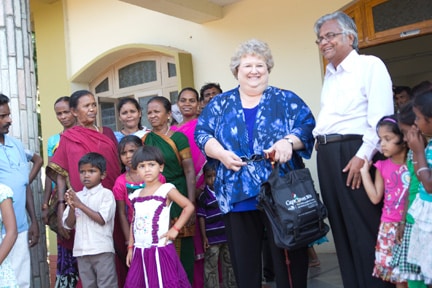Are You Ready to Change?

by Liz Gold
When you have been doing something for almost twenty years, you had better be able to change with the times. If you aren’t, get out of the way because you are certain to get run over and left behind.

Liz Gold with Pastor Lalsingh. Photo courtesy Liz Gold.
When you have been doing something for almost twenty years, you had better be able to change with the times. If you aren’t, get out of the way because you are certain to get run over and left behind. God placed me in a very strategic and exciting role many years ago and has entrusted me with the opportunity to make change, accept change, and change myself.
The Church
Calvary Church in Santa Ana, California, was founded in 1931. From its beginning, it has had missions in its DNA, sending out and supporting individuals financially, emotionally, and spiritually. Over four hundred Calvary members have gone overseas as career missionaries to countries around the world.
Today, we have over ninety families on our roles. This includes twenty retired families/individuals (many in their eighties) and a dozen national missionary families. Each has been supported through our Faith Promise giving since 1967. Hundreds more have served in short-term capacities which have led to many becoming full-time missionaries. Others have been trained through our Future Missionary Focus individualized training program, and in 2012 fourteen students headed to the 2012 Urbana Missions Conference.
…during a Time of Change
In 1994, I transitioned into my role at Calvary. There was a hiring freeze, several staff had left, and we were in the midst of senior pastors. It was indeed a time of great change and Calvary’s mission giving dropped with the loss of people. Only with some additional funds that had been saved for a “rainy day” were we able to pull through financially.
In late 1995, our newly-appointed senior pastor, David Mitchell, came to Calvary. In time, he made some changes—one of the most important for missions was a move from ministry boards to ministry team. This change eliminated elected positions and allowed staff to select people with a passion for their ministry. With a new team open to new ideas, I could make changes to our ministry which would allow us to move Calvary’s global mission program in a new direction.
We had one big problem, however: we had a congregation with an incorrect response to the question of why we “did missions” at Calvary Church. A survey questionnaire gave the number one answer as “to support our missionaries.” Our focus had been caring for our missionaries to the extent that people had forgotten the real reason we were supporting them in the first place! Additionally, many in the congregation only saw their role as financial. This change would be tantamount to moving a big ship.
A New Missional Vigor
After much prayer, research, and several meetings with mission specialists and our team, we had a plan. We had to help our congregation remember what missions was really about—reaching a lost world for Jesus Christ. We also had to remind them that this goal wasn’t just the job of missionaries; it was their responsibility as well. Three months prior to our mission conference of March 2000, we mailed out a document called Vision 2005, explaining our goals and plans, including new ways we would be focusing on global missions. The new ventures included:
• Supporting agency partnership projects in parts of the world where our missionaries weren’t serving
• Bible and curriculum printing and distribution
• Media and radio
• Support and scholarships for national workers and pastors
• Various building projects
• Holistic work
In addition, we would:
• Limit new missionaries to only supporting those headed to the least-reached people groups
• Begin personally including members in short-term missions and helping them connect with internationals at local colleges through missionaries working with the students
• Challenge them to increase their giving to help make these things possible
The congregation caught the vision. Our giving increased greatly and continued to increase every year thereafter over the next five years. Hundreds of people served on short-term mission trips and began to see missions as something they could be involved in themselves. Their answer to my question changed as well. It was more like: “Calvary missions is sharing Christ around the world to as many people as possible, in as many ways as possible, which includes the support of our missionaries.” A little change changed a lot of hearts. Change is possible, but we must have a well-thought-out plan. We must pray over it with faith that God is in it. We must present it clearly and make it something people can become personally passionate about doing.
Bridging the Church-Agency Divide
Sometimes change is about doing something others aren’t doing. Early on, I was told that meeting with mission agency representatives was a waste of time. Most of my fellow mission pastors weren’t doing it and advised me against it. I had “inherited” my ninety families and with them over forty mission agencies.
I wrote to the agencies and told them that I wanted to meet. I wanted to know their work and I wanted them to know that I really cared about our missionaries. This change not only allowed them to get to know Calvary, but has been crucial during times of crisis (e.g., evacuations, bombings, accidents, deaths). Because of these relationships with agency leaders, we have been contacted early on and thus proactively involved in decisions with our missionaries.
These relationships have also led to partnerships for special projects which have proved to be great resources for mission conference speakers, national missionary opportunities, and up-to-date print and DVD materials. We are often invited to participate in their conferences or dinners, where we meet with other global mission leaders. This also means that we have our hand on the pulse of what is happening in missions around the world.
For example, a recent trip to India included opportunities to visit mission works I would not have known about without previous connections with agency representatives.
Almost ten years have passed since we introduced Vision 2005. With globalization through Facebook and other social networks, churches raising support for global missions face great competition for financial support. We are looking again at what we need to change to connect with our people. Part of my reason for visiting India was to find something our people could become passionate about supporting in addition to our missionaries. Before leaving for India, I received a phone call from the agency representative for Partners International. She wanted me to talk with Sagar Lalsingh about his work in India with the Banjara people. I talked with him for thirty minutes and decided it was important to see this work.
The Banjara are a nomadic gypsy-type people group of over forty million in number spread across sixteen states, in over four hundred districts in India. They live in small settlements called “Thandas” which are far from the main town areas. They practice a peculiar type of worship, mostly of idols and spirits. They believe in animal sacrifices and faithfully perform them every year as rituals. Most of this people group is forgotten and neglected.
I visited with Rev. Dr. B. Lazarus Lalsingh, executive director of (BBPT) Badavo Banjara Phosear Trust—Empowering the Banjara Leaders. He had descended from this people group. Through his ministry, they have sent out workers to meet the needs of the unreached Banjaras people wherever they are. My change in plans, two days before leaving for India, wouldn’t have happened without the connection to this agency representative who, because of our relationship, knew I was headed to India.
Bridging the Local-Global Divide
Sometimes change is uncomfortable. It can come about because of changes that other people make. When changes come from leadership, we have two choices—leave, or make the best of the changes. About five years ago, Calvary began a greater focus on local outreach. With this came a “branding” of REACH Local and REACH Global. I decided a great way to use this to our ministry advantage and to clarify our differences to the congregation was through a new mobilizing source.
We began writing a publication called REACH, with articles about our two different and yet similar ministries. It also allowed us to distinguish how each ministry is supported—global through Faith Promise’s separate gifts and local through the general ministry tithes. Our ministries work off each other, allowing people to start building their ministry skills locally before going overseas and doing a similar work globally.
In addition, many of our other ministry areas promote their REACH activities through the publication, allowing the congregation to see that REACH permeates all we do at Calvary. Our REACH Local pastor, Matt Doan, is a great advocate of REACH Global and promotes it. Accepting and working with change may be uncomfortable at first, but it is good for stretching us as individuals and can be a blessing to our ministry areas as well.
And Then There Is Policy…
Sometimes change happens with the missionaries and in the mission program. These are usually when one’s ministry vision or focus changes. It is crucial to have a mission policy in order to know what we are doing and why we are doing it. Without a policy we are like a ship without a compass—no direction, just blowing in the breeze. Our written global mission statement is: “Calvary Church desires to take the Gospel to those who have not heard, encourage those believers who are persecuted for their faith, and equip those of the body who do not have the resources and opportunities that we enjoy.”
Our mission policy has been regularly updated and reworked to allow ministry to happen. Over the years, there have been all manner of change for our missionaries—location, ministry type, agency, single to married to widowed, new births, empty nesters, etc. Saying no to requests is never easy, but we must be ready to stand by our mission policy and vision and mission statement, even when it’s difficult.
It’s important for all of us to remember why we are here in the first place: to change lives and hearts for eternity. Second Corinthians 2:14-17 says it this way:
But thanks be to God who is Christ always leads us in triumphal procession, and through us spreads the fragrance of the knowledge of him everywhere. For we are an aroma of Christ to God among those who are being saved and among those who are perishing, to one a fragrance from death to death to the other a fragrance of life to life. Who is sufficient for these things? For we are not like so many, peddlers of God’s word, but as men of sincerity, as commissioned by God, in the sight of God we speak in Christ.
Here’s hoping that you know why you are called and Who has called you—and that you are enjoying the change he is making in you every day.
….
Liz Gold is mission director of Calvary Church of Santa Ana, California, overseeing US$1.1 million supporting 90+ families and several partnership projects. She’s a board member of DualReach and was a delegate for the 2010 Lausanne Congress at Cape Town.
EMQ, Vol. 49, No. 2, pp. 228-232. Copyright © 2013 Evangelism and Missions Information Service (EMIS). All rights reserved. Not to be reproduced or copied in any form without written permission from EMIS.





